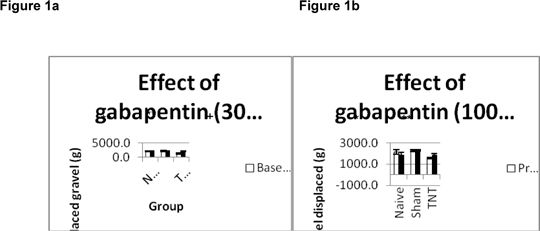Print version
Search Pub Med
Burrowing behaviour of rats is reduced by peripheral nerve injury and reinstated by gabapentin: a novel assay of spontaneous behaviour affected by chronic pain Pain leads to a reduction in spontaneous behaviours e.g. rearing (Matson et al 2007) therefore reinstatement of spontaneous behaviour should be an effective property of clinically effective analgesics. Here we describe experiments studying the effect of traumatic peripheral nerve injury (PNI), and hence neuropathic pain, on the spontaneous behaviour of burrowing in rat. Burrowing was performed broadly according to the method Deacon, (2006). Rats were habituated and exposed to plastic tubes containing 2500g of gravel over 3 days. Then baseline burrowing during 60 min was established over 2 consecutive days. The next day rats were allowed 60 min to burrow freely and the gravel remaining in the tube was weighed. Rats were randomly assigned to naive, sham or nerve injury groups and though the method is completely objective, experimenters were blind to surgery and drug treatment. Exclusion criteria in controls & pre-test were determined prior to testing as rats not displacing more than 500g of gravel. Experiments evaluated the effects of 1) compounds in rats with no pain and 2) three different methods of inducing PNI i.e. tibial nerve transection (TNT), L5 sciatic nerve transection (SNT) and peripheral spared nerve ligation (PSNL). TNT rats were housed with naive and shams and L5 SNT and PSNL rats were housed in same surgery groups. TNT rats were tested 40 days post surgery and L5 SNT and PSNL rats were tested 14 days post surgery. Both morphine (4 mg/kg sc; n = 6) and gabapentin (100 mg/kg sc; n = 6) significantly reduced burrowing activity in surgically naive rats relative to vehicle and baseline (n = 6); see Table 1. Table 1
** P<0.01 & *p<0.05 post-hoc bonferroni test vs appropriate saline control. All PNI’s (n = 6, TNT, n = 10, PSNL, n = 11, SNT) significantly reduced rat burrowing compared with appropriate controls (n = 6 for TNT and n = 19 for PSNL & SNT) by approximately 30% relative to their baseline level of burrowing (naive pre = 1911±107g, post = 1962±76g; sham PSNL pre = 2101±130g, post = 1812±124g; PSNL pre = 2237±138g, post = 1778±146g, p<0.01 paired t-test; sham SNT pre = 2061±158, post = 1642±143g, p<0.05 paired t-test; SNT pre = 2088±162g, post = 1562±158g, p<0.05 paired t-test). Gabapentin (30 mg/kg sc; n = 6) but not 100 mg/kg sc (n = 6) reversed the deficit induced by TNT (see Figure 1a & 1b).

Baseline analysed using ANOVA with Bonferroni post hoc tests vs TNT baseline. Baseline vs gabapentin analysed with paired t-test +p<0.05, **p<0.01. The level of mechanical hypersensitivity in rats with any PNI did not correlate with the deficit in burrowing. These experiments show that measurement of the spontaneous behaviour of burrowing in rats has the potential to dissociate the effect of a selective analgesic dose of gabapentin from one inducing motor impairment in the same animal. While ongoing work aims to evaluate non-traumatic PNI to exclude any motoric confound it is concluded that this may be a potentially important and relatively simple, novel assay for measuring the effect of analgesics using a behavioural endpoint that does not rely wholly on evoking a reflex and that is relevant to the rodent.
Deacon, RMJ (2006) Nature Protocols 1: 118-121 Matson et al (2007) JPET: 320 194-201
|
|||||||||||||||||||||||||

